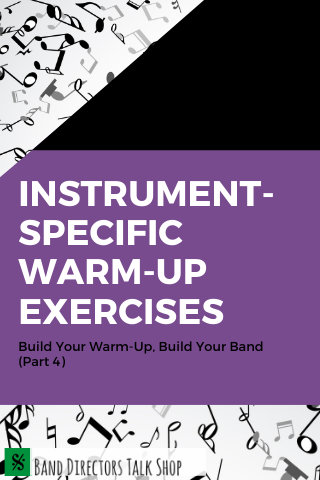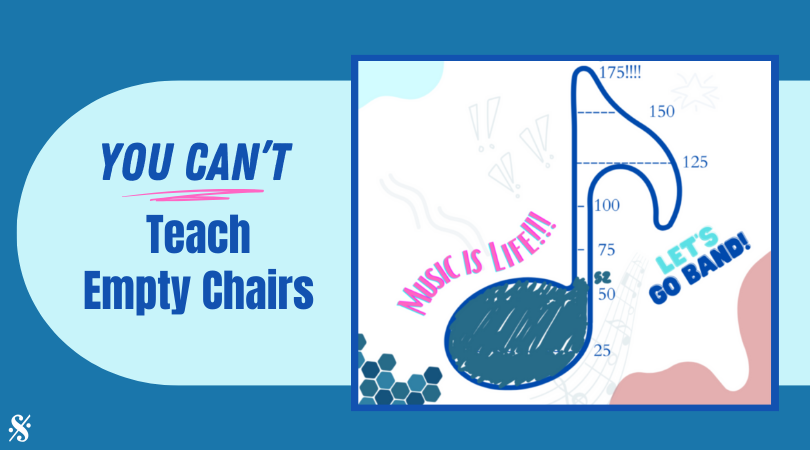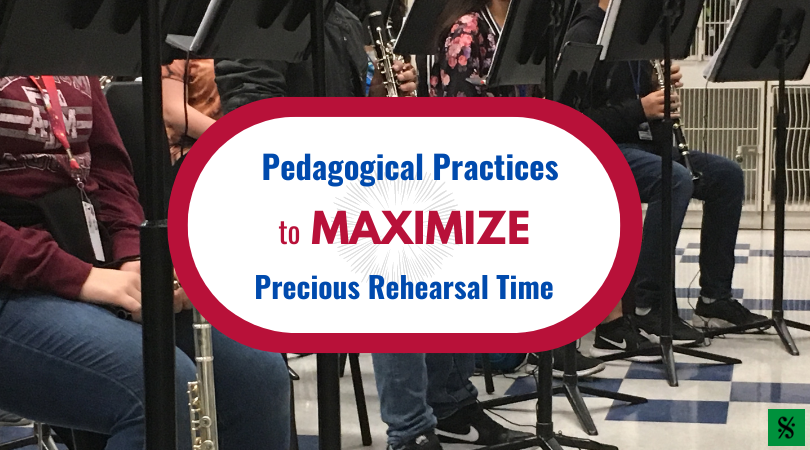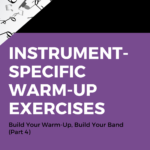This is the final article in a series discussing the process of building a warm-up that will grow your group’s abilities through creating connections. In this post, I will look at some warm-ups that you can provide students with for individual practice. These also work great in sectionals.

Instrument-Specific Warm-Up Exercises:
Woodwinds:
Practice in the following manner: Flute- headjoint, Clarinet- mouthpiece and barrel, Saxes- mouthpiece only, Double reeds- reed only.
Practice with just the mouthpiece (Clarinet with barrel), headjoint, reeds. Play an open free tone. Clarinets produce a high reedy pitch. Saxes a low reedy pitch (like a goose call). Double reeds crow 2 or more pitches and also play the reed as if on the instrument. Flutes produce a vibrant resonant whistle. You can move into producing specific pitches easily with a flexible embouchure.
Reed players need to:
- Feel like the lips are holding the reeds along their sides.
- Remember reed vibrations = resonance.
- Use a hearty reed tone- get the heart of the vibrating not just the tip.
- Air goes over the rails, not just through the center of the reed.
All woodwinds need to move air to the end of the instrument, not stop at the open keys.
Focus on the cheek muscles stretching forward to support the embouchure instead of thinking that the embouchure holds the mouthpiece, etc. Embouchure must remain free to adjust and create the appropriate aperture.
After a solid tone is produced, move into creating vibrato and articulations with just the headjoint, mouthpiece or double reeds. Starting vibrato early actually prevents many other issues. On flute it contributes to aperture focus. On the reeds it really helps prevent biting to hold the mouthpiece or reeds, as well as tongue positioning and developing the lips as a cushion while relying on good air to vibrate the reeds. For clarinets and saxes, it forces them to put top teeth on mouthpiece and not rest reed on bottom lip.
Articulating on just the mouthpiece/reeds develops great independence of the tongue. To maintain the same tone while tonguing, students learn that only the tip of the tongue can be employed without causing some kind of detriment to the tone.
Making sure that your woodwinds maintain the proper tone while playing on the mouthpiece/reeds with either a straight tone, vibrato or while articulating will build a great foundation.
Flute:
Tongue Up Headjoint: (After they have played on the headjoint for 1 month.) Place the tip of the tongue lightly touching the roof of the mouth right above the gum line. While the tongue is touching the roof of the mouth, make a tone on the headjoint. They have to relax their face muscles and the bottom lip will naturally flatten out on the lip plate.
Tongue Up D: (For students who have been playing at least 2 month.) Place the tip of the tongue lightly touching right above the gum line. Play fourth line D while keeping the tongue touching above the gum line. In order for the D to play you will have to relax the facial muscles so that the air can go around the tongue to the aperture. You will also have to stretch the top lip down in order to create a relaxed, tiny, focused aperture.
Whisper F: (For students who have been playing at least 3 months.) Finger High F; start with lips completely together. Blow only enough air to play the high F at a pp dynamic. Aperture must be super small and stretching forward. This will develop a super focused aperture with great air focus.
Overtones: (For students who have been playing at least 4 months.) Overtones are a great way to further develop aperture and air focus. It will also develop their high note clarity. Overtones are where you finger one note but play another note a partial or more above.
Clarinets:
- Add the register key to notes early in their development to help them build fast air and firm embouchure.
- To provide support, the bottom lip moves forward to add firmness to the heart of the reed, not biting up to the tip.
- Practice soft, resonant high notes.
- Play 2nd line G. Without the register key, bottom lip supports the heart of the reed firmly to produce a high D. Air needs to be fast for this to occur.
- Learning vibrato forces them to anchor the mouthpiece against their top teeth.
Saxes:
- Proceed to low notes early in their playing. This keeps them open and prevents resting the mouthpiece on the bottom lip.
- Develop vibrato early as well. Use as an exercise to keep them from biting the reed.
- Learning vibrato forces them to put their top teeth on the mouthpiece.
- Drops: Finger top staff G. While keeping octave key depressed, drop jaw to play 2nd line G.
- Once control of the low notes is gained, they should start doing octaves and overtones.
Oboe:
Reed Shifts: develops voicings
- With just the reed, Play Ab. Next play Ab again and shift (gliss) up to a Bb and back to Ab. After you are comfortable with this, begin on Ab and shift to Bb then to C and then back down to Ab. Finally, shift from Ab to Bb to C to Db and then back down to Ab.
- The more reed in your mouth makes the pitch go higher. Use the mouth to move the reed inward and back out. Your hand is only to keep from dropping the reed, not to move the reed in and out of your mouth.
- Give energy and direction to shift notes. Watch for biting as you get to C. It’s not pressure but fast air and voicing that create higher pitches.
- OO shape in aperture and EE shape in tongue.
Long tones and Dynamics:
- Long tones on reed alone to learn how to finish notes.
- Sound a Bb on the reed alone. Crescendo to your best forte, then decrescendo to silence without a pitch change. Keep air moving no matter what. Softer is farther away. To get softer, dampen 1 blade but not both.
Bassoon:
- Play an F on the reed alone.
- Play either a C or C# on the bocalphone. (Reed and bocal)
- On the bocalphone use C# to play: long tones, articulation patterns, dynamics.
- You can also cover the whole reed with your mouth and adjust pitch with just your air and tongue. No lip pressure. You can also drop the jaw and use air and tongue to change pitch.
- Play bassoon with no reed to warm up your air and instrument.
- Hold bassoon almost vertical. Balance points hip, left hand knuckle, right hand palm.
Brass:
Employ the wind principals of warm-ups for everything you play.
- Play all notes as relaxed as possible while maintaining the fastest air possible. Be aware if you start to sacrifice one for the other.
- Keep a smooth, relaxed aperture. A relaxed aperture will: keep lips closer together naturally, buzz a lot faster or a lot slower, adjust easier, not get fatigued quickly.
- Range success is not the goal. How we train for range is the goal. Consistent tone, air etc. in all ranges is all that matters. Using our muscle structures and air in a relaxed, productive manner is priority. Cracked notes played correctly are better than notes produced by tight, pinched muscles and air.
- High notes are less air moving faster.
- Stable corners. While the amount of firmness of the corners varies by instrument, we want to use our air and tongue position as the primary source of control.
- Sing often.
- Focus on vibrating the instrument, not just the lips.
As you practice any of these exercises concentrate on maintaining steady corners, practice playing soft, learn to use your tongue arch and less air moving faster as you go higher. Play without pinching the center of the lips.
Buzzing: Just the mouthpiece. Lead pipe buzzing: Trumpet, French Horn, Euphonium, Tuba remove main tuning slide. Trombone remove the slide. Buzz through sirens. Not all pitches are available but you can feel how it’s the air that activates the instrument’s nodes and not the lips. Full Instrument: Instrument completely assembled.
Buzzing: start without using the tongue. Buzz softly. Keep the corners as still as possible. Focus on air, tongue arch and aperture size as you move up and down. Buzz as high as you can with the shank open. Then, partially cover the end of the shank with your pinky and buzz with the back pressure to develop high range. As you go higher focus on less air moving faster as the aperture gets smaller.
Mouthpiece Buzzing/Sirens, Lead Pipe Buzzing/Sirens, Full Instrument Sounds/Sirens. Match the feeling of the aperture to all 3 forms. Listen for a round, open, resonant tone without any tension, pinching or tightness. Aperture is along for the ride, not to start the notes.
- Lip slurs are fundamental to brass development. Practice soft.
- Flow studies. Play soft and slow. Feel where the air vibrates the metal.
- Slow scale practice for consistency of tone.
- Lip vibrato is helpful for keeping students from using too much pressure on the mouthpiece.
Percussion:
Less is more. Keep body movements to a minimum.
Stretching:
- 2 Finger pulls, Wrist pulls- both hands, Palm up fingers down extend- L/R Hand, Palm down fingers up extend- L/R Hand, Arms down palms back curl fingers
- Stick Spins: Hold a stick in each hand and spin your wrist back and forth.
- Stick Dribble: With a normal grip, raise your hands up near your ears so that your sticks are parallel to ground and pointing back. While maintaining a proper grip, use your fingers to let the sticks rotate in the fulcrum up and down to simulate a double bounce. Watch hands to see if you are creating the same grip in both hands.
- 8 on a hand. 8 taps with right hand. 8 taps with left hand. 1 wrist stroke, 7 finger bounces.
- Match stick tap between right and left hands, between single and double bounces. Tips stay close, thumb alignment, uniform stick height.
Play through rudiments that are appropriate for your level. Start slow. Increase tempo while maintaining proper grip, rebound, stick height, tap. Practice on rim also and listen for rhythmic precision.
Final Thought
Every year is a new year for teachers and chances are we need to adjust our warm-up. Each year we have a different group; different skill levels, different developmental abilities etc. Let’s approach our warm-up with a fresh evaluation of our students’ abilities. Keep in mind that we want to build habits that will carry over into their performances. Think to yourself, “Is my warm-up making my band better? What am I specifically trying to improve, build, grow? Do I have a goal for everything I put in my warm-up? Am I strengthening the connection between fundamentals and performance?”
I hope these pages have sparked some ideas for your warm-up routine. Have a great warm-up.
Steve Giovanoni is in his 23rd year of teaching. He is currently in his 12th year at Randolph Field ISD in Universal City, TX. While at RFISD he has taught Band, Dual Credit Music Appreciation and Music Theory courses.
Related Reading:
Why Every Trumpeter Should Practice Their Mouthpiece – Part 1
Setting Goals and Achieving Objectives – Practice Tips for the Modern Musician
Tunes with a Twist – Unison Lines for Full Band
If you would like to receive our weekly newsletter, sign up here.
Don’t forget to like us on Facebook too!
Learn. Share. Inspire.
BandDirectorsTalkShop.com






Leave a Reply
You must be logged in to post a comment.